Where is Brazil?
About Brazil
The Land
The People
Life and Death
Health, Energy and the Environment
Education and Work
Travel, Communication and the Media






Back to the Flags of South America page




Brazil is a vast country in the east and centre of South America.
Brazil has a border on the Atlantic Ocean.
The land is mostly flat lowlands in the north, some plains, hills and mountains and a narrow coastal strip.
The geographical coordinates for the centre of Brazil, also known as lines of latitude and longtitude, are:-
Latitude - 10 00S
Longitude - 55 00W
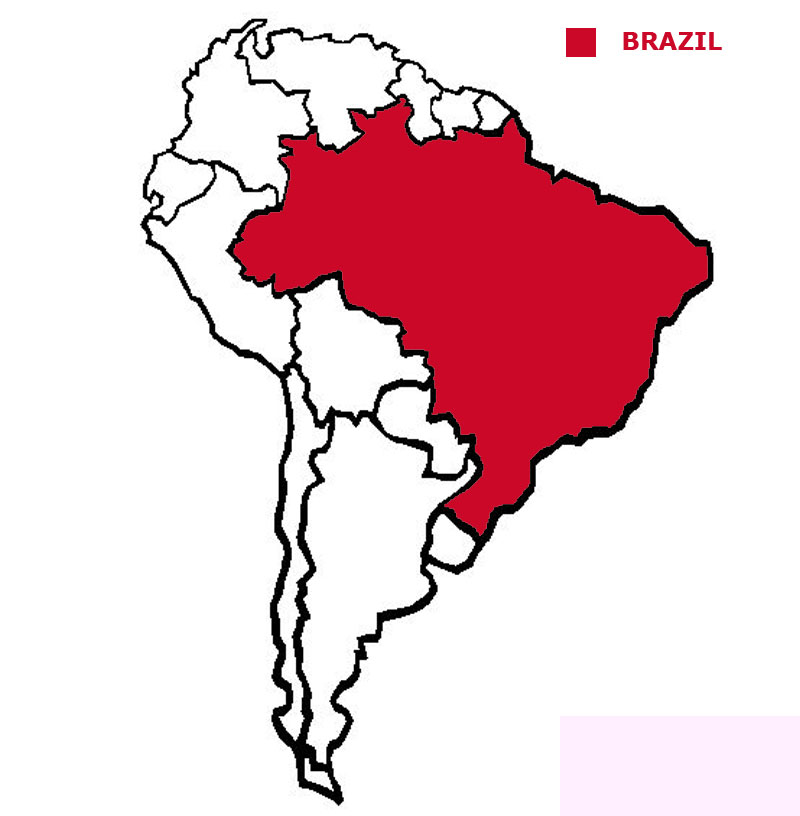

Check the weather in Brasilia now.
This is the time in Brasilia now
 The Brazilian flag is green with a large yellow
diamond containing a blue globe. There are 27 white stars scattered around the globe. The globe has a central white band with the words
Ordem E Progresso which means Order and Progress. The stars represent the various states within Brazil. The yellow diamond is roughly the shape of Brazil.
The Brazilian flag is green with a large yellow
diamond containing a blue globe. There are 27 white stars scattered around the globe. The globe has a central white band with the words
Ordem E Progresso which means Order and Progress. The stars represent the various states within Brazil. The yellow diamond is roughly the shape of Brazil.
Brazil is a presidential republic with a president as head of state and head of government.
In elections everyone over the age of 18 and under the age of 70 must vote. It is voluntary for those between 16 and 18 and those over 70. Members of the military cannot vote.
The currency in Brazil is the real.
Portuguese is the official language.
Hear the National Anthem
These are the anthem words
We have already written our own history of England but are asking schools in Brazil to provide us with a detailed history of
their own country. Check how here.
![]()
![]() Back to the top
Back to the top

The total land area of Brazil is 8,358,140 sq kms which is the largest in South America.
Brazil has lakes, rivers and canals which total 157,630 sq kms.
Brazil has boundaries with 10 countries
- Bolivia 3,403 kms
- Peru 2,659 kms
- Venezuela 2,137 kms
- Colombia 1,790 kms
- Paraguay 1,371 kms
- Guyana 1,308 kms
- Argentina 1,263 kms
- Uruguay 1,050 kms
- The French dependency of Guiana 649 kms
- Suriname 515 kms
Brazil has a coastline of 7,491 kms which is the longest in South America.
The highest point in Brazil is Pico da Neblina at 2,994 metres.
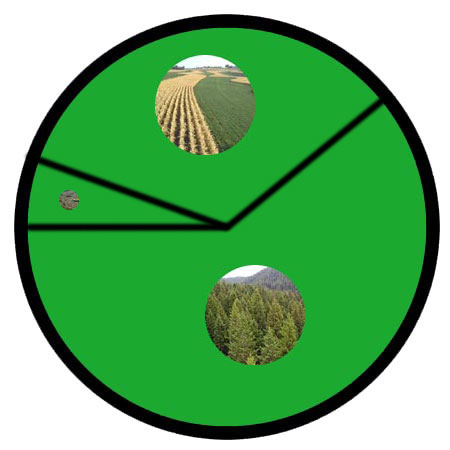

The total population of Brazil is 205.82 million people, making it the largest country in South America by population.
Of this number 104.32 million are females and 101.50 million are males.
A person from Brazil is called a Brazilian.
To be a citizen of Brazil you must be born in Brazil or one of your parents must be a citizen of Brazil. You have to live in Brazil for
4 years before you can begin to apply for citizenship.
The largest five cities in Brazil, by population are:-
- Sao Paulo 10,021,295 people
- Rio de Janeiro 6,023,699
- Salvador 2,711,840
- Fortaleza 2,400,000
- Belo Horizonte 2,373,224
 Each little Owlbut is 1 person and
the big yellow rectangle is 1 sq km. After a while you can compare countries and see which ones are the most crowded. Remember it is only an average as
more people live closer together in towns and cities than in villages out in the country.
Each little Owlbut is 1 person and
the big yellow rectangle is 1 sq km. After a while you can compare countries and see which ones are the most crowded. Remember it is only an average as
more people live closer together in towns and cities than in villages out in the country.
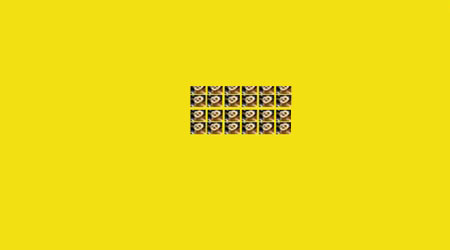
85.7% of the people live in cities or towns.

The birth rate in Brazil is 14.3 births per 1,000 of population
The death rate in Brazil is 6.6 deaths per 1,000 people.
Check this against the birth rate. If the death rate is higher than the birth rate then
the population will decrease unless immigrants arrive in the country.
There are 14.7 deaths of girls under 1 year per 1,000 of births and 21.2 deaths of boys.
The median age for females is 32.4 and for males is 30.7. The median age is that age which divides the population exactly in half so there are the same number
of people above the median age as below it.
We have no figures for the average age of a woman when she has her first child is 29.9.
The elderly dependency ratio is 11.4. This is the number of elderly people (ages 65+) per 100 people of working age (ages 15-64).
The potential support ratio is 8.7. This is the number of working-age people (ages 15-64) per one elderly person (ages 65+). As a population ages, the potential support ratio tends to fall, meaning there are fewer potential workers to support the elderly.
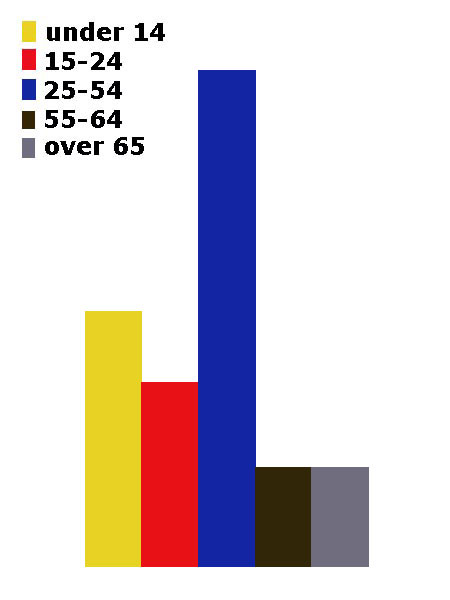
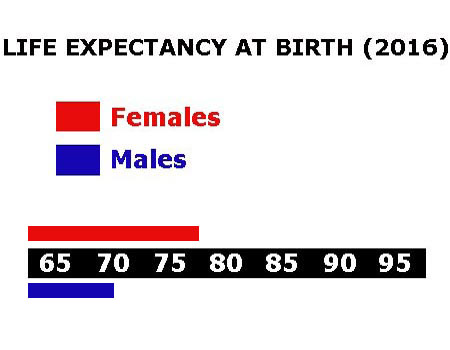

Brazil spends 8.3% of its total income on health care.
There are 1.89 doctors per 1,000 people.
There are 2.3 hospital beds per 1,000 people.
22.1% of the population are estimated as obese.
100.0% of the urban population and 87.0% of the rural population have drinking water that is either piped into their home or they have access to a public tap, a protected borehole, well, spring or
protected rainwater collection facility.
88.0% of the urban population and 51.5% of the rural population have access to a flushing toilet that is connected to a sewer. a pit latrine (that is a
permanent hole in the ground that is looked after) or a composting toilet.
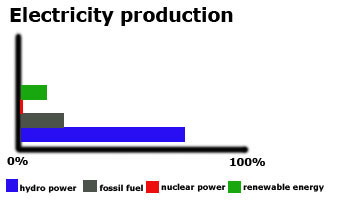
Brazil releases 535.0 million metric tons of carbon dioxide by burning fossil fuels in the process of producing and consuming energy. This puts it as the highest in South America.

Brazil spends 6.0% of its total income on education.
Children usually start school at age 6 in Brazil. Primary education is for nine years until age 15. Secondary education, which is not compulsory,
can continue to 18. This may be followed
by further education at a university or college.
Generally the school year consists of 2 terms and starts in the first week of February and finishes in the middle of December. There is usually a 2 week
break in the middle of July.
92.9% of females and 92.2% of males are able to read and write by the age of 15.
30.2% of all people aged between 16 and 24 are not in work. Among females 35.0% are unemployed while with males 26.5% can't find work.
The total number of people available for work in Brazil is 110.40 million.
 They work in the following sectors.
They work in the following sectors.
- Agriculture includes farming, fishing and forestry work
- Industry includes mining, manufacturing, construction and energy workers
- Services is everything else

There are 698 paved airports in Brazil, which is the highest number in South America.
![]()
There are 29,849 kilometres of railways in Brazil, the longest in South America.
![]()
There are 212,798 kilometres of roads in Brazil, which means Brazil is in 1st place for the most kilometres of roads in South America.
![]()
There are 6 major national newspapers in Brazil.
There are 257.81 million mobile phone users.
21% of the people have a fixed landline.

120.68 million people have access to the internet at home via any device (computer or mobile).


